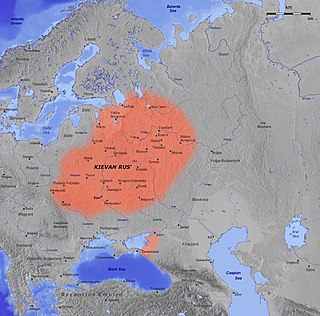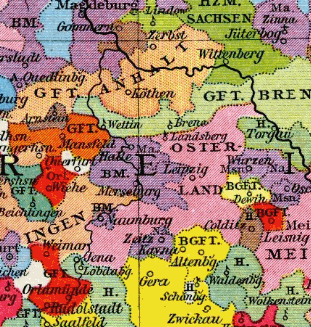Life
John studied at the University of Leipzig, and in Cologne. He was dean of Magdeburg, a canon of Meissen, provost at Bautzen and then magister scholarum of the cathedral chapter in Meissen. Pope Innocent VIII appointed him bishop, even though the cathedral chapter objected. The lucrative silver mining at Schneeberg continued. John III had a habit of appointing relatives to ecclesiastical offices, including two of his brothers. There indications that he may have been temporary mentally "confused" towards the end of his life.
In 1511 the chapter proposed to appoint canon Vincent of Schleinitz as coadjutor, but the House of Wettin saw to it that their candidate Philip of the Palatinate was appointed instead.
John died in 1517 and was buried in Naumburg Cathedral. A bronze plaque of his tomb has survived.

Year 968 (CMLXVIII) was a leap year starting on Wednesday of the Julian calendar.

The Archbishopric of Magdeburg was a Latin Catholic archdiocese (969–1552) and Prince-Archbishopric (1180–1680) of the Holy Roman Empire centered on the city of Magdeburg on the Elbe River.

Naumburg is a town in the district Burgenlandkreis, in the state of Saxony-Anhalt, Central Germany. It has a population of around 33,000. The Naumburg Cathedral became a UNESCO World Heritage Site in 2018. This UNESCO designation recognizes the processes that shaped the European continent during the High Middle Ages between 1000 and 1300: Christianization, the so-called "Landesausbau" and the dynamics of cultural exchange and transfer characteristic for this very period.
A Diocesan Administrator is a provisional ordinary of a Catholic particular church.

Julius von Pflug was the last Catholic bishop of the Diocese of Naumburg from 1542 until his death. He was one of the most significant reformers involved with the Protestant Reformation.

Nikolaus von Schönberg was a German Catholic cardinal and Archbishop of Capua.

The Diocese of Dresden–Meissen is a Latin Church diocese of Catholic Church in Germany with its seat in Dresden. It is suffragan to the Archdiocese of Berlin.

Naumburg Cathedral, located in Naumburg, Germany, is the former cathedral of the Bishopric of Naumburg-Zeitz. The church building, most of which dates back to the 13th century, is a renowned landmark of the German late Romanesque and was recognised as a UNESCO World Heritage Site in 2018. The west choir with the famous donor portrait statues of the twelve cathedral founders (Stifterfiguren) and the Lettner, works of the Naumburg Master, is one of the most significant early Gothic monuments.

The Bishopric of Merseburg was an episcopal see on the eastern border of the medieval Duchy of Saxony with its centre in Merseburg, where Merseburg Cathedral was constructed. The see was founded in 967 by Emperor Otto I at the same time in the same manner as those of Meissen and Zeitz, all suffragan dioceses of the Archbishopric of Magdeburg as part of a plan to bind the adjacent Slavic ("Wendish") lands in the Saxon Eastern March beyond the Saale River more closely to the Holy Roman Empire.

George III, Prince of Anhalt-Dessau, was a German prince of the House of Ascania and ruler of the principality of Anhalt-Dessau, and also a Protestant Reformer. After 1544 he became the first ruler of the principality of Anhalt-Plötzkau.
Gisilher, Gisiler or Giseler was the second Archbishop of Magdeburg, succeeding Saint Adalbert, from 981 until his death in 1004.
Gunther was the Margrave of Merseburg from 965 until his death, upon which the march of Merseburg was united to that of Meissen.
Wichmann von Seeburg was Bishop of Naumburg from 1150 until 1154 and Archbishop of Magdeburg from 1154 until his death. He became the first Magdeburg prince-archbishop in 1180

The Diocese of Görlitz is a Latin Church diocese of the Catholic church in Germany. The current ordinary is Wolfgang Ipolt

Philip of the Palatinate was Prince-Bishop of Freising (1498–1541) and Naumburg (1517–1541). He was a member of the house of Wittelsbach, and the son of Elector Palatine Philip the Upright and Margaret of Bavaria. Among 14 children, he was the second oldest son. Several contemporary portraits of him are known.

The Prince-Bishopric of Naumburg-Zeitz was a medieval diocese in the central German area between Leipzig in the east and Erfurt in the west. The seat of the bishop was Zeitz Cathedral in Zeitz from 968 and 1029 and Naumburg Cathedral in Naumburg between 1029 and 1615. It was dissolved in the wake of the Reformation. The Bishopric of Zeitz-Naumburg encompassed the four archdeaconries of Naumburg, Zeitz, Altenburg and "trans Muldam".
Adalbert of Saxony was administrator of the Archdiocese of Mainz as Adalbart III.

Melchior von Meckau (1440–1509) was a German Roman Catholic cardinal and bishop.
Eido I, also Ido, Eid or Ägidius, was the bishop of Meissen from 992 to 1015.
This page is based on this
Wikipedia article Text is available under the
CC BY-SA 4.0 license; additional terms may apply.
Images, videos and audio are available under their respective licenses.










